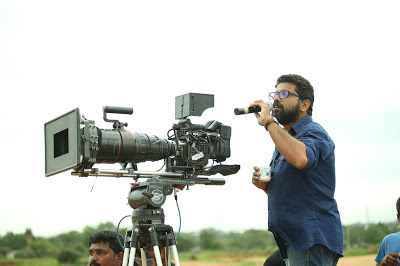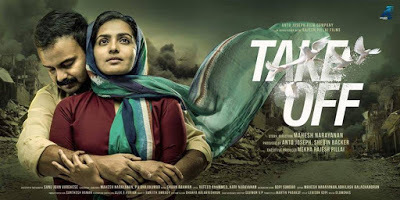Shevlin Sebastian's Blog, page 73
May 5, 2017
Praised By Priests And Nuns
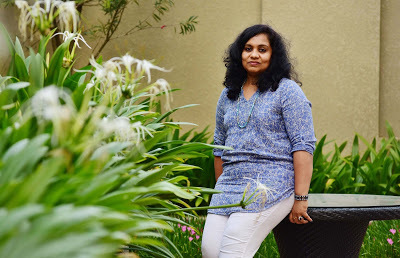 COLUMN: LOCATION DIARY
COLUMN: LOCATION DIARY By Shevlin Sebastian
“Jibu was very close to his uncle,” says Sophia. “So, when he received the news on the set, at Kozhikode, he became extremely upset. He started crying and could not work any more. It was a big shock for me, too.”The film's shoot was done mostly in a housing colony at Bilathikulam. And soon, the crew came to know of a very old lady, who was a favourite among the residents. “And then, suddenly, she died,” says Sophia. “This was also a shock.” To show solidarity and respect, the shoot was cancelled for a day. It was after this that Sophia got the idea of getting the clergy interested in the film. So, a special screening was organised for Cardinal George Alencherry, several bishops, priests and nuns. “Soon the priests began to talk about the film in their Sunday sermons,” says Sophia. “Suddenly, in the Christian belts in Kerala, there was a huge increase in the audience. This was one of the reasons why our film became a superhit.”(The New Indian Express, Kochi, Thiruvananthapuram and Kozhikode)
Published on May 05, 2017 02:00
May 4, 2017
People And Buildings
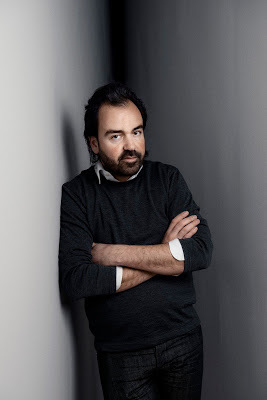
 The Dutch-based photographer Iwan Baan talks about his work, during a recent visit to Kochi
The Dutch-based photographer Iwan Baan talks about his work, during a recent visit to KochiPhotos: Iwan Bahn by Jonas Ericksson; a Chandigarh scene
By Shevlin Sebastian
When the Dutch-based photographer Iwan Baan arrived in Kochi, the heat him so hard, he had to mop his face several times with a handkerchief. But he adjusted quickly, as he delivered a talk, organised by the Indian Institute of Architects, Cochin Centre, at the Bolgatty Palace.
But this was not Iwan's first visit to Kerala. Five years ago, he had come to take photographs of the buildings made by the late architect Laurie Baker. “He was an architect who did amazing things, with minimal means,” says Iwan. “I found it very appealing.”
Asked to describe the buildings in Kochi, he says, “In tropical climates, nature grows so fast around concrete structures,” says Iwan. “There is a kind of exuberance and an openness to buildings.”
In fact, Iwan's next book is on Bangladesh, which has a similar climate like Kerala. In August, he is planning to spend three weeks in Bangladesh during the middle of the monsoons. “The water and the monsoon play an important part in how people construct their buildings,” he says.
Iwan is known the world over as being one of the earliest to focus on people, rather than on buildings, as most architectural photographers did. “I wanted to tell stories about a place through the people, as well as the buildings,” he says. “Why is the structure in that particular location? How does the city evolve and change around it? Who are the people who live near it? And in it?”
Thus far, he has taken photos in places as diverse as the Western Sahara, Peru, United Kingdom, USA, Australia, Bahrain, Lebanon, Taiwan, Brazil, Scotland, Azerbaijan, Mexico, China and India.
In India, he has shot in Delhi, Mumbai, Varanasi and several other places. “Tradition plays an important part in the construction of buildings in India,” he says. “And that makes it fascinating.”
Interestingly, when Iwan goes to a new place, he does not do too much of research. “That's because I like to look at a place with the freshness of a child's eye,” says Iwan, who passed out from the Royal Academy of Art in The Hague.
For his work, Iwan uses a Canon EOS-ID X Mark 11 because he prefers a smaller camera. Thus far, his output has been much appreciated. Iwan is the recipient of the inaugural Julius Shulman award for photography (2010) as well as the Stephen A. Kliment Oculus Award given by the American Institute of Architects last year. His work has been featured in prestigious magazines and newspapers like 'The Wall Street Journal', 'The New York Times', and the 'Architectural Digest'.
Regarding the qualities needed to be a good photographer, Iwan says, “You should have an endless curiosity about people and places. There is always something new to see. And you should have an urge show it to the world. In other words, you need a tremendous passion for the job.”
Which Iwan also possesses. And his incessant travels have given him a sharp insight about people. “What I have observed is the unquenchable thirst for life among ordinary folks,” he says. “They want to make the most of what they have, even under difficult circumstances. When you show interest in their cultures, people are quick to invite you into their homes. This type of hospitality is universal. As a result, I have been blessed with so many unforgettable moments.”
(The New Indian Express, Kochi and Thiruvananthapuram)
Published on May 04, 2017 03:19
May 1, 2017
Bonhomie Beyond Borders
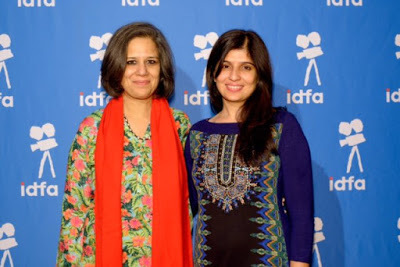
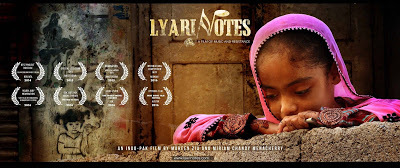 ‘Lyari Notes’ is a documentary about four girls, who live in a suburb of Karachi, and try to learn music among the violence and mayhem
‘Lyari Notes’ is a documentary about four girls, who live in a suburb of Karachi, and try to learn music among the violence and mayhemPhotos: Filmmakers Maheen Zia (left) and Miriam Chandy Menacherry; the poster of the film
By Shevlin Sebastian
‘Someday I will see, So will you, When bread will become cheaper, And life will be precious, Such a day will surely come for Pakistan’
These lyrics are part of a song sung by a group of children, at the Music Art and Dance (MAD) school at Karachi, while principal Hamza Jafri smiles indulgently. This is a scene from the documentary, ‘Lyari Notes’, which was shown recently at the Kochi Muziris Biennale.
The film is about the lives of four girls, Aqsa, Mehroz, Sherbano and Javeria, who live in one of the most violence-prone areas of Karachi called Lyari. And even as they dodge bullets and mayhem, they try to learn music at the MAD school.
You know 'Lyari Notes' is an unusual film, when, in the beginning credits, the words, 'An Indo-Pak Production' can be seen. And it is indeed a collaboration with the Mumbai-based documentary film-maker, Miriam Chandy Menacherry and Maheen Zia of Karachi.
But what was even more usual was that they never met till one-and-a-half years into their partnership, and, that too, in Holland, because the film was co-funded by the International Documentary Festival of Amsterdam. So Maheen would shoot in Lyari and send the rushes to Miriam and she would edit it. “Both of us felt that if I went to Lyari, it would be a big distraction,” says Miriam.
The idea for the film came when Miriam, a music buff, happened to see songs of Pakistani underground artists on You Tube and found it very political and saucy. One which became a viral hit was ‘Aalu Anday’ (‘Potato and eggs’), which was sung by the Lahore-based 'Beygairat Brigade'. “The song was a lampooning of the political system, as well as the military,” says Miriam.
And another artist that Miriam came across was Hamza. “He also had put up videos making hard-hitting political statements,” says Miriam. “Then I came to know that Hamza runs a music school and that became the starting point for the film.”
It is a moving film and touches on a host of subjects: whether music is acceptable in Islam, the massacre of 132 children at the Army Public school in Peshawar by the Taliban on December 16, 2004, as well as discussions about the impact of Malala Yousafzai winning the Nobel Peace Prize in 2014.
Regarding the film’s message, Miriam says, “We wanted to represent the voice of the silent majority. The news out of Pakistan in the mainstream media is always about guns and violence. We wanted to capture the everyday life of people, even as they get caught up in the violence around them.”
(Sunday Magazine, The New Indian Express, South India and Delhi)
Published on May 01, 2017 21:54
April 27, 2017
The End Of The Road

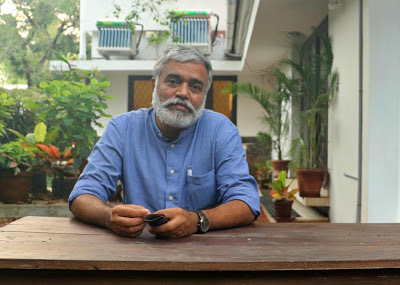 At a discussion on death and dying, at Fort Kochi recently, participants aired their fears and concerns
At a discussion on death and dying, at Fort Kochi recently, participants aired their fears and concernsPhoto: Dr. Suresh Kumar
By Shevlin Sebastian
When yoga expert Nuthan Manohar saw a Facebook post mentioning a talk about dying and death, at Fort Kochi, she was keen to go. “I found the subject fascinating,” she says. “After all, every breath you take is bringing you closer to death. You need to think about it, because most of us live in denial of death.”
The discussion on death and dying was moderated by Dr. Suresh Kumar, one of the leading lights of palliative care in Kerala and the Founder-Director of the Institute of Palliative Medicine in Kozhikode, a World Health Organisation Collaborating Centre. He is also a Honorary Senior Research Fellow at the University of Bradford, UK, as well as a Ashoka Fellow.
Interestingly, when Suresh asked the audience which death touched them the most recently quite a few, including Nuthan spoke about the death of animals.
Nuthan had two kittens, Hedley and Unda. She had taken them to a vet's clinic, for grooming. However, owing to the presence of infected cats, both her kittens contracted the parvovirus and died within days. “I couldn't understand why something so innocent and powerless had to die so painfully,” says Nuthan. “What was God’s role in this?”
Suresh is not surprised by Nuthan's reaction. When asked about the reaction of terminally-ill patients, Suresh says, “Many of them have questions about the meaning of their life. It is a time when they take stock. They think about the issues they want to settle before they leave. Sometimes, they think, 'Is it okay to die?' If a person is a young father, then it is a painful feeling that he will not be there, for his wife and children. Some will think, 'What will happen to my bank balance and all the possessions that I have acquired? What will happen to me in the afterlife?'”
There are other concerns, too. Do you want a life support system, or do you prefer to die at home? Do you want to be cremated or buried? Has it been discussed? “One participant said that her father did not want any rituals,” says Nuthan. “But after his death, this request was ignored by the family and all the rituals were done.”
Interestingly, very few people say that they are afraid of death. “They will call it a worry or concern,” says Suresh. “A fairly good percentage feels remorseful about certain things they did in their life. They want to make amends, although it may be late. They tell me, 'If I get another six months, I will do things differently'.”
Meanwhile, the good news is that, in terms of palliative care, Kerala is way ahead of the rest of the country. “Out of 1500 centres in India, 1300 are in Kerala,” says Suresh. “Kerala is one place where the common man is involved in the care of dying people.” Suresh is also running similar projects in Puducherry, West Bengal and Manipur, as well as Indonesia, Thailand, Sri Lanka, and Bangladesh.
Asked about his own experience at viewing death so often, Suresh says, “It reminds me of the fragility of life. It tells me that my time is limited. I will be taking the same path tomorrow or after a few years. It is only a matter of time. So, each moment counts. I tell myself, ‘When I die, I should have minimum things to regret’.”
As for what happens after death, a stoical Suresh says, “I don't believe anything happens after death. I am a non-believer. Life ends. That is all.”
(The New Indian Express, Kochi and Thiruvananthapuram)
Published on April 27, 2017 22:59
April 25, 2017
Obedient Snakes And Hyper-Active Monkeys

 COLUMN: LOCATION DIARYPhotos: Saloo George taken by Melton Anthony; the poster of 'Kashmeeram'Amazingly, the snake looked up and left quietly. Unni had names for every snake in the vicinity. Another day, when another snake came, Unni said, “Ramakrishnan, stop being a nuisance. Go away.” And once again, the snake left.
COLUMN: LOCATION DIARYPhotos: Saloo George taken by Melton Anthony; the poster of 'Kashmeeram'Amazingly, the snake looked up and left quietly. Unni had names for every snake in the vicinity. Another day, when another snake came, Unni said, “Ramakrishnan, stop being a nuisance. Go away.” And once again, the snake left.(The New Indian Express, Kochi, Thiruvananthapuram and Kozhikode)
Published on April 25, 2017 22:45
April 24, 2017
A Daughter Remembers
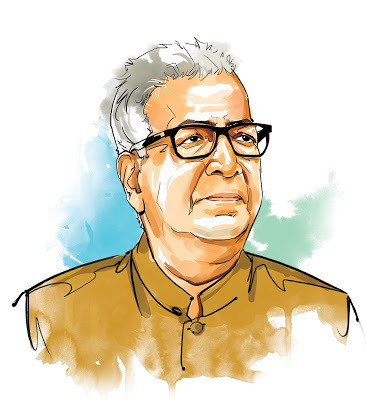
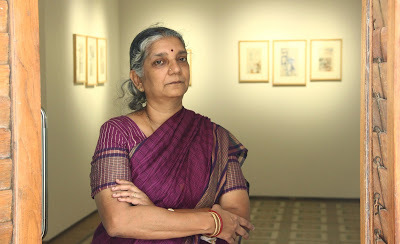 Uma Padmanabhan, the only child of the late artist KG Subramanyan, talks about her father. A month-long exhibition of his works is taking place at Kochi
Uma Padmanabhan, the only child of the late artist KG Subramanyan, talks about her father. A month-long exhibition of his works is taking place at KochiPhotos: Illustration of KG Subramanian by Sai Nath; Uma Padmanabhan; photo by Melton Antony
By Shevlin Sebastian
Thanks to a Rockefeller Foundation grant, Subramanyan was spending the year, 1966-67, in America. So, Uma studied at a school in New York. And it was there that Uma realised that her father was an artist. “Appa was doing drawings on egg cartons,” says Uma. “He also did acrylic paintings, tapestry work and fibre weaving. I was seeing this for the first time.”
The Baroda-based Uma had come to Kochi to attend the inauguration of her father’s one-month long exhibition (till May 19) called ‘Sketches, Scribbles, Drawings’ at the Durbar Hall. There is a poignant look on her face as she gazes at her father’s work. “I enjoyed the animals that he drew,” says Uma. “He has also done portraits of me, but that is now with an art collector.”
When her mother Susheela Jasra, an artist as well as a Gandhian social worker, passed away on February 28, 2005, it became Uma's responsibility to look after her father. So, she would spend two weeks with her husband in Mumbai and the rest of the month in Baroda. “Whenever I would come back, I would be amazed at the number of sketches and canvases Appa had done,” says Uma.
One reason for Subramanyan's prolific and varied output – paintings, sculptures, drawings, graphics and illustrations – was because he led a disciplined life. Every day, after breakfast, he would enter his studio at 9.30 a.m. For the next several hours, he would work, before breaking off for lunch. Following a nap, he would return to the studio by 3.30 p.m. He stopped work at 5 p.m.
“At night, he would do something or the other,” says Uma. “It could be either scribbling, or writing poems.”
Father and daughter would have long conversations. And he passed on to Uma his philosophy of life. “Appa told me to avoid gossiping or criticising people,” says Uma. “He should I should be friendly with everybody and help them.”
Subramanyan, himself, had a helping attitude. When young artistes would come to the house, he would be friendly, co-operative and encouraging. And when they held their exhibitions, he would always attend them.
So, it is no surprise that the passing away of this artistic icon has left a vacuum in Uma's life. All the people who would come to meet Subramanyan, at their bungalow at Sama have stopped coming. They ring Uma up and promise to come, but none of them do. “The world is selfish,” says Uma. “It is more so in the art fraternity. People became friendly with my dad because they felt they could gain something. Most of them were not sincere.”
Meanwhile, recently, Uma went through a poignant moment. While cleaning a cupboard, she came across a brand-new saree that her father had bought her and which she had not used. “Tears started rolling down my face, as I remembered Appa,” she says.
(The New Indian Express, Kochi and Thiruvananthapuram)
Published on April 24, 2017 23:12
April 23, 2017
Highlighting Nutritious And Healthy Food
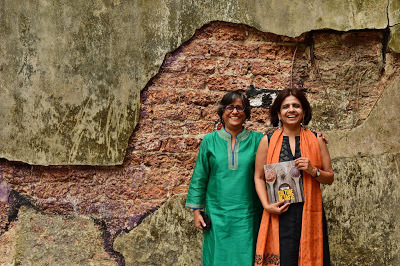

The book, 'First Food: Culture of Taste' focuses on traditional Indian foodPhotos: Vibha Varshney (left) and Sunita Narain; the book cover. Pics by Albin Mathew
By Shevlin Sebastian
Every morning, the Kolha and Santhal tribals of Mayurbhanj in Orissa pluck chakedopaah (pennywort). Then they prepare a chutney and have it with their breakfast of watered rice. The tribal belief is that a few leaves a day enhances memory and checks body tremors among the old.
Meanwhile, members of the Lingayat community of Karnataka take the leaves of the narale (grape family) and make a chutney. Elderly people in the community believe that the chutney consumed once a year prevents cough and stomach infections and strengthens muscles and bones.
When food and nutrition consultant Sangeeta Khanna got married, she noticed her mother-in-law boil the leaves of the parijaat (night-flowering jasmine) to make kadha (a herbal mixture) to ease the pain in her joints.
These are examples from 'First Food – Culture of Taste', a stylish cookery book brought out by the Centre of Science and Environment (CSE).
The idea to do the book came up when reporters of 'Down To Earth' magazine, (a sister organisation of the CSE), would return from field trips and inform the editors about the varieties of food that they ate. “That's how we started working on the project more than a decade ago,” says book editor Vibha Varshney. “'Culture of Taste' is the second book in the 'First Food' series.” (The earlier book, published in 2013, was called, 'A Taste of India's Biodiversity').
But there was another urgent reason. “We want to revive India’s traditional culture of eating home-cooked food with seasonal ingredients,” says CSE Director Sunita Narain. “It was getting lost because we are losing the holders of that knowledge – our mothers and grandmothers. Our food today is getting 'multinationalised', 'industralised' and 'chemicalised'. In short, it is a McDonalidisation of food.”
The book has been divided into different sections: leaves, flowers, fruits, vegetables and seeds. “This is the pattern followed by rural communities. They consume all parts of the plant, like the leaves, flowers and fruits, as and when they became available. This method ensures the availability of food throughout the year,” says Vibha.
For example, in Dindori district of Madhya Pradesh, when tender pink leaves appear on the peepal tree towards the end of March the locals cook and eat it. Then during the spring season, everybody picks a leaf or two and chews it, because it strengthens the teeth. Later, the bark and the fruits are also consumed. “This is a method that urbanites can also follow,” says Vibha.
Meanwhile, when asked about the target readership, Vibha says, “It is for those who want to eat healthy food. This option is available in our Indian diet, but we have overlooked it. It is far more healthier and nutritious than the processed food that we eat now.”
Book Details
Title: 'First Food – Culture of Taste'
Publisher: Center for Science and Environment
Pages: 218
Price: Rs 950.
(Sunday Magazine, The New Indian Express, South India and Delhi)
Published on April 23, 2017 22:49
April 22, 2017
The Dark Side Of Childhood
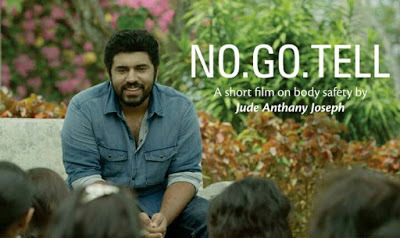
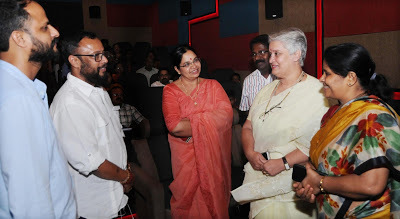 Director Jude Anthany Joseph has made a short film, which stars Mollywood star Nivin Pauly, and highlights the safety measures that children need to take
Director Jude Anthany Joseph has made a short film, which stars Mollywood star Nivin Pauly, and highlights the safety measures that children need to takePhotos: the short film; (From left: Directors Jude Anthany and Lal Jose, dubbing artist Bhagyalakshmi, Shobha Koshy,Chairperson of the Kerala State Commission for Protection of Child Rights and compere Shobha Vijayabhanu
By Shevlin Sebastian
A few months ago, Shobha Koshy, the Chairperson of the Kerala State Commission for Protection of Child Rights was sitting in her office at Thiruvananthapuram. Suddenly, she looked out of the window and saw somebody who looked like Mollywood film director Jude Anthany Joseph. But she was not sure.
However, a couple of minutes later, her assistant came and told her, “The director of ‘Ohm Shanti Oshaana’ wants to see you.”
And when Jude told Shobha he wanted to make a film about child sex abuse, she felt very happy.
Shobha was talking at the launch of the seven-minute film, ‘No. Go. Tell’. The film starts with a group of girls playing in a park. Some are on the swings, while a few are on the sea-saw. Through the entrance, Nivin Pauly enters. The girls recognise him and they get all excited. He greets them as he settles down on a bench. Soon, the group sits on the grass in front of him.
“There are certain parts of the body which no stranger should touch,” says Nivin. “These are the lips, chest, buttocks and between the legs.”
And he tells the children that they should learn to identify two types of touches: good and bad touches. When parents touch the child it is a good touch, but not a stranger. And when somebody does try, there are three safety measures.
“One is so say No loudly, the second is to Go away from the person and the third is to Tell a trusted person like a parent, grandparent, or a teacher,” says Nivin. “If a stranger wants to give you sweets or ice-cream, or tries to show you some videos, you must walk away.” The film ends with a song by the children. And the all-India Childline helpline number 1098 is flashed on the screen.
Earlier, Shobha had said that when you open the newspaper you are confronted all the time with reports of child sex abuse. “People ask me, 'Is this really true? Are there so many cases happening?',” says Shobha. “Unfortunately, I cannot compare with earlier times, because we don't have any statistics. But the difference today is that more people are speaking about the issue.”
To get an idea of the scale of the problem, the Commission has been collecting data for the past two years. “And the findings are disturbing.,” says Shobha. “The largest number of abuse does not happen with strangers. It happens within the family and the neighbourhood. It happens not just for girls, but boys, too.”
The best way, of course, is by creating awareness. “Children are the most vulnerable and yet they need to be sensitised,” says Shobha. “We, at the Commission, were quite excited when Jude came forward. They are people who can create a ripple in society.”
Director Lal Jose, who was present at the viewing, says, “Only by seeing the film did I understand the seriousness of the issue. But it is also very important that children receive the right kind of message. If there comes a point when a father cannot hug his child, because everybody is under a cloud of suspicion, it will be very sad. And I say this as a father of two daughters. But having said this, this is a really well-made film and we need more films like this to spread the message in our society.” Dubbing artiste Bhagyalakshmi also spoke.
'No. Go. Tell’ has been brought out by the NGO Bodhini, with a sponsorship from the Muthoot Pappachen Foundation.
(The New Indian Express, Kochi and Thiruvananthapuram)
Published on April 22, 2017 02:53
April 19, 2017
ISIS Slogans And Saddam's Poster
Published on April 19, 2017 00:02
April 16, 2017
The Rhythms Of Life
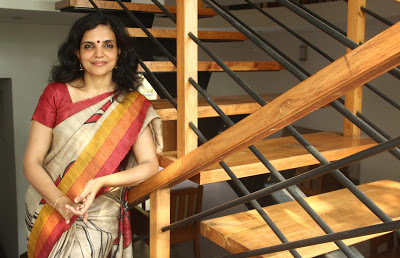
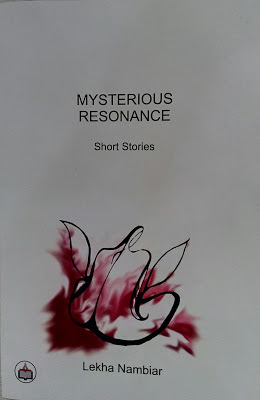 English teacher Lekha Nambiar has brought out an engaging collection of short stories
English teacher Lekha Nambiar has brought out an engaging collection of short storiesPhotos: Lekha Nambiar. Pic by Melton Anthony; the book cover
By Shevlin Sebastian
It is not every day that one's debut collection of short stories can get a preface written by a noted writer. But the introduction to Lekha Nambiar's 'Mysterious Resonance' was written by none other than the award-winning writer M. Mukundan.
And this is what he wrote: 'These stories are written in English, but the author is a Malayalee. There aren't many female Malayalee writers writing in English. Though a debutante, Lekha's voice is to reckon with. When you have read all the stories in this collection, you will have a better understanding of the working of a woman's mind.'
This is indeed an engaging collection of stories, mostly, from a woman's viewpoint, but there are some interesting exceptions. In 'Umbrella', Lekha has written it from the point of view of an umbrella: 'It took around two weeks for the first customer to pick me up. I instantly hated his rough hands and lecherous eyes. He was so outrageously insensitive that when he carried me in his arms, his nails almost pierced my soft flesh'.
Most of the stories are just two or three pages long. And it is an easy read, with simple sentences and spare imagery.
Despite this spareness, she is able to convey a lot. In 'Mindscape, Lekha writes about two women friends, who set out on an outing towards a mountain and later, stop at a pond:
'They removed their clothes feeling no shame around their naked bodies. Like a pair of majestic swans, they skimmed on the glassy surface of the water. Kavitha wrapped her arms around Sukanya and both laced their fingers together. As the luscious unevenness of their flesh created soft ripples, they mutually adored their feminine grace. After swimming for some time, the girls walked towards the bank in a dreamy langour. In the baking heat, both exhausted each other with long caresses.'
“This story is a celebration of the physicality of two females, and an exploration of feminine sensuality,” says Lekha. “In fact, those who read it told me there is a lesbian touch to the story, although I was not aware of it when I wrote it.”
Sometimes, she gets her inspiration from real life. In 'Agony', Lekha has written about a woman who is married to a man who speaks very little, while she is talkative. “This is a similar experience of a good friend of mine,” says Lekha. “That is her agony. It is an unrequited love. So I made it into a story but I used my imagination also.”
The 18 stories have been divided into three sections: 'Nuances of Love'; 'Some Existential Affairs' and 'Strands of Reminiscence'.
The last section is autobiographical. These include memories of her dance teacher, college mates and friends, as well as amusing encounters with her own grandmother.
Here is an extract:
'After about a year when I went to see my grandmother, she gathered me to her breasts and softly murmured into my ears.
“Give me some poison.”
With a shudder I sprang up and burst out, “What? Poison!”
With a glint in her eyes, she replied, “Yeah.... that perfume you gave me last time.'
Incidentally, Lekha took five years to write the book. That is because she has a full-time job as an English teacher at the Jama-Ath Higher Secondary school at Thandakkad, near Perumbavur. Whenever she would find time, Lekha would scribble something. The end result is a promising debut.
The book, priced at Rs 195, has been brought out by Authors Press and is available on Flipkart and Amazon.
(The New Indian Express, Kochi and Thiruvananthapuram)
Published on April 16, 2017 22:16

